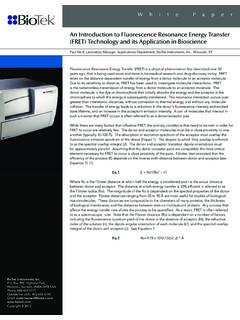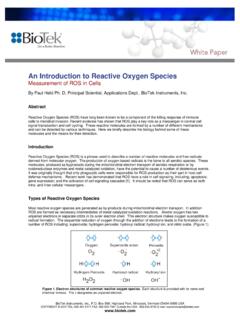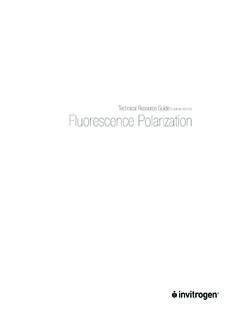Transcription of Sample Preparation for Fluorescence Microscopy: An ...
1 Sample Preparation for Fluorescence microscopy : an introduction Concepts and Tips for Better Fixed Sample Imaging ResultsWhite PaperBioTek Instruments, Box 998, Highland Park, Winooski, Vermont 05404-0998 USAP hone: 888-451-5171 Outside the USA: 802-655-4740 Email: 2015 Multiple processing steps are required to prepare tissue culture cells for Fluorescence microscopy . Experiments are generally classified as being either live or fixed cell microscopy . Fluorescence microscopy of live cells uses either genetically encoded fluorescent proteins ( GFP, mcherry, YFP, RFP, etc.)
2 Or cell membrane-permeable, non-toxic fluorescent stains. Fluorescence microscopy of fixed cells uses a fixative agent that renders the cells dead, but maintains cellular structure, allowing the use of specific antibodies and dyes to investigate cell morphology and structure. Appropriate Sample Preparation is necessary to ensure high quality images are captured. Here we describe a number of concepts and considerations regarding the Sample Preparation process that can assist with automated digital Fluorescence microscopy of fixed Paul Held, Laboratory Manager, Applications Dept.
3 , BioTek Instruments, Fixation The goal of fixation is to maintain cellular structure as much as possible to that of the native or unfixed state during the processing steps and subsequent imaging. There are a number of fixation methods suitable for Fluorescence microscopy that fall into two basic categories: aldehyde fixatives and alcohol fixatives. Organic solvents such as alcohols and acetone remove lipids and dehydrate the cells, while precipitating the proteins on the cellular architecture. Cross-linking aldehyde reagents form intermolecular bridges, normally through free amino groups, creating a network of linked antigens.
4 Cross-linkers preserve cell structure better than organic solvents, but may reduce the antigenicity of some cell components, and require a permeabilization step to allow the antibody access to the specimen. Fixation with both methods may denature protein antigens, and for this reason, antibodies prepared against denatured proteins may be more useful for cell staining. As each method has its advantages and disadvantages and because different fixative methods can destroy or mask different epitopes, several different methods may need to be tested for optimal fixatives cross link proteins and generally do an excellent job of preserving cell morphology.
5 While they are generally slower acting than organic based fixatives, 4% formaldehyde for 10 minutes at room temperature is a good starting point. Glutaraldehyde will also cross link proteins, but results in significant autofluorescence and generally should be avoided or used in low concentration in conjunction with formaldehyde. Note that glutaraldehyde is the preferred fixative of choice for electron vs. Paraformaldehyde vs. FormalinParaformaldehyde is a polymer of formaldehyde. It exists as a dry powder suitable for storage, and needs to be broken down into its monomeric component formaldehyde.
6 This is accomplished by heating under basic conditions until it becomes solubilized. Commercial formaldehyde solutions generally referred to as formalin, often contain methanol to prevent re-polymerization into paraformaldehyde. A saturated formalin solution has formaldehyde content in water or buffer of 37-40% and is sometimes referred to as 100% formalin . Therefore using 10% formalin (1:10 dilution) is equal to using formaldehyde for fixation. Since 100% formalin contains up to 15% of methanol as a stabilizer, it can have a significant impact on fixation. This is mainly the result of membrane permeabilization by methanol, which results in the interference in the staining of membrane bound : Cytation 3 and Cytation 52 White PaperPrepare a fresh 4% formaldehyde solution by dissolving paraformaldehyde powder into PBS (PH ) using a stirring hot plate with the heater set to a medium setting until the liquid reaches approximately 60 C.
7 As the paraformaldehyde breaks down to formaldehyde it will dissolve. Once the solution is completely dissolved (approx 30 min), the solution is quickly chilled on ice back to room temperature prior to use. Typically, tissue culture cells are fixed for 10 minutes at room temperature with 4% paraformaldehyde in PBS followed by 2-3 washes with PBS to remove excess formaldehyde and stop the fixing Organic solvents such as methanol rapidly precipitate proteins, maintaining structure when doing so. While the cellular protein cytoskeletal structure is maintained with methanol fixation, small molecules within will be lost during the subsequent processing steps because they are not precipitated.
8 Because methanol precipitates proteins never use this method if genetically encoded fluorescent proteins are to be imaged or detected - activity from these proteins will be abolished with methanol fixation. Methanol is used cold (-20 C) for 10-20 minutes. Using a combination of methanol and acetone (1:1) can sometimes improve results. Methanol is best for preserving structure while acetone improves permeabilization. Following fixation samples are washed with PBS 2-3 times to remove alcohol and rehydrate the specimen. Buffer Selection Another important considerationof a fixation protocol is the buffer selection.
9 Ideally the buffer is isotonic in nature so as to not disrupt cellular structure, while maintaining a pH as close to physiologic as possible. The most frequently used buffer is phosphate buffered saline (PBS). When using aldehydes as fixatives avoid using amine-containing buffers, such as Tris, as they will react with the fixative. Permeabilization Fixation with the use of cross linking agents does not effectively diminish cell membrane structure. Therefore, formaldehyde fixation requires the cells to be permeabilized to allow antibodies access into the interior of cells. The large size and ionic nature of antibody proteins precludes them from gaining access without membrane disruption (Figure 1-2).
10 Alcohol and acetone based fixation generally does not require this step. Digitonin, Leucoperm and Saponin are relatively mild detergents that generate large enough pores for antibodies to pass through without completely dissolving the plasma membrane. These are suitable for antigens in the cytoplasm or the cytoplasmic face of the plasma membrane (Figure 1). Saponin acts by dissolving cholesterol present in the plasma membrane. When used at low concentrations, internal membranes remain intact so it is useful for labeling smaller molecules that exist in a soluble state within the cytoplasm.














